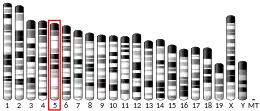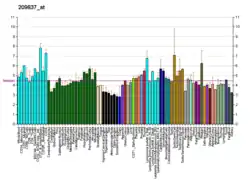| AP4M1 | |||||||||||||||||||||||||||||||||||||||||||||||||||
|---|---|---|---|---|---|---|---|---|---|---|---|---|---|---|---|---|---|---|---|---|---|---|---|---|---|---|---|---|---|---|---|---|---|---|---|---|---|---|---|---|---|---|---|---|---|---|---|---|---|---|---|
| |||||||||||||||||||||||||||||||||||||||||||||||||||
| Identifiers | |||||||||||||||||||||||||||||||||||||||||||||||||||
| Aliases | AP4M1, CPSQ3, MU-4, MU-ARP2, SPG50, adaptor related protein complex 4 mu 1 subunit, adaptor related protein complex 4 subunit mu 1 | ||||||||||||||||||||||||||||||||||||||||||||||||||
| External IDs | OMIM: 602296 MGI: 1337063 HomoloGene: 3467 GeneCards: AP4M1 | ||||||||||||||||||||||||||||||||||||||||||||||||||
| |||||||||||||||||||||||||||||||||||||||||||||||||||
| |||||||||||||||||||||||||||||||||||||||||||||||||||
| |||||||||||||||||||||||||||||||||||||||||||||||||||
| |||||||||||||||||||||||||||||||||||||||||||||||||||
| |||||||||||||||||||||||||||||||||||||||||||||||||||
| Wikidata | |||||||||||||||||||||||||||||||||||||||||||||||||||
| |||||||||||||||||||||||||||||||||||||||||||||||||||
AP-4 complex subunit mu-1 is a protein that in humans is encoded by the AP4M1 gene.[5][6][7]
Function
This gene encodes a subunit of the heterotetrameric AP-4 complex. The encoded protein belongs to the adaptor complexes medium subunits family. This AP-4 complex is involved in the recognition and sorting of cargo proteins with tyrosine-based motifs from the trans-golgi network to the endosomal-lysosomal system.[7]
Interactions
Clinical relevance
The AP4-complex-mediated trafficking plays a crucial role in brain development and functioning.[9] Mutations of the gene cause spastic paraplegia 50, one of the many subtypes of spastic paraplegia.
References
- 1 2 3 GRCh38: Ensembl release 89: ENSG00000221838 - Ensembl, May 2017
- 1 2 3 GRCm38: Ensembl release 89: ENSMUSG00000019518 - Ensembl, May 2017
- ↑ "Human PubMed Reference:". National Center for Biotechnology Information, U.S. National Library of Medicine.
- ↑ "Mouse PubMed Reference:". National Center for Biotechnology Information, U.S. National Library of Medicine.
- ↑ Wang X, Kilimann MW (Feb 1997). "Identification of two new mu-adaptin-related proteins, mu-ARP1 and mu-ARP2". FEBS Lett. 402 (1): 57–61. doi:10.1016/S0014-5793(96)01500-1. PMID 9013859. S2CID 81844290.
- ↑ Dell'Angelica EC, Mullins C, Bonifacino JS (Apr 1999). "AP-4, a novel protein complex related to clathrin adaptors". J Biol Chem. 274 (11): 7278–85. doi:10.1074/jbc.274.11.7278. PMID 10066790.
- 1 2 "Entrez Gene: AP4M1 adaptor-related protein complex 4, mu 1 subunit".
- ↑ Hirst J, Bright NA, Rous B, Robinson MS (August 1999). "Characterization of a fourth adaptor-related protein complex". Mol. Biol. Cell. 10 (8): 2787–802. doi:10.1091/mbc.10.8.2787. PMC 25515. PMID 10436028.
- ↑ Abou Jamra R, Philippe O, Raas-Rothschild A, Eck SH, Graf E, Buchert R, Borck G, Ekici A, Brockschmidt FF, Nöthen MM, Munnich A, Strom TM, Reis A, Colleaux L (June 2011). "Adaptor protein complex 4 deficiency causes severe autosomal-recessive intellectual disability, progressive spastic paraplegia, shy character, and short stature". Am. J. Hum. Genet. 88 (6): 788–95. doi:10.1016/j.ajhg.2011.04.019. PMC 3113253. PMID 21620353.
External links
Further reading
- Stephens DJ, Banting G (1998). "Specificity of interaction between adaptor-complex medium chains and the tyrosine-based sorting motifs of TGN38 and lgp120". Biochem. J. 335 (Pt 3): 567–72. doi:10.1042/bj3350567. PMC 1219817. PMID 9794796.
- Hirst J, Bright NA, Rous B, Robinson MS (1999). "Characterization of a Fourth Adaptor-related Protein Complex". Mol. Biol. Cell. 10 (8): 2787–802. doi:10.1091/mbc.10.8.2787. PMC 25515. PMID 10436028.
- Aguilar RC, Boehm M, Gorshkova I, et al. (2001). "Signal-binding specificity of the mu4 subunit of the adaptor protein complex AP-4". J. Biol. Chem. 276 (16): 13145–52. doi:10.1074/jbc.M010591200. PMID 11139587.
- Boehm M, Aguilar RC, Bonifacino JS (2002). "Functional and physical interactions of the adaptor protein complex AP-4 with ADP-ribosylation factors (ARFs)". EMBO J. 20 (22): 6265–76. doi:10.1093/emboj/20.22.6265. PMC 125733. PMID 11707398.
- Simmen T, Höning S, Icking A, et al. (2002). "AP-4 binds basolateral signals and participates in basolateral sorting in epithelial MDCK cells". Nat. Cell Biol. 4 (2): 154–9. doi:10.1038/ncb745. PMID 11802162. S2CID 28781777.
- Strausberg RL, Feingold EA, Grouse LH, et al. (2003). "Generation and initial analysis of more than 15,000 full-length human and mouse cDNA sequences". Proc. Natl. Acad. Sci. U.S.A. 99 (26): 16899–903. Bibcode:2002PNAS...9916899M. doi:10.1073/pnas.242603899. PMC 139241. PMID 12477932.
- Scherer SW, Cheung J, MacDonald JR, et al. (2003). "Human Chromosome 7: DNA Sequence and Biology". Science. 300 (5620): 767–72. Bibcode:2003Sci...300..767S. doi:10.1126/science.1083423. PMC 2882961. PMID 12690205.
- Ota T, Suzuki Y, Nishikawa T, et al. (2004). "Complete sequencing and characterization of 21,243 full-length human cDNAs". Nat. Genet. 36 (1): 40–5. doi:10.1038/ng1285. PMID 14702039.
This article is issued from Wikipedia. The text is licensed under Creative Commons - Attribution - Sharealike. Additional terms may apply for the media files.




